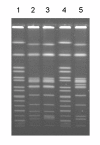Single nucleotide polymorphisms that differentiate two subpopulations of Salmonella enteritidis within phage type
- PMID: 21942987
- PMCID: PMC3220660
- DOI: 10.1186/1756-0500-4-369
Single nucleotide polymorphisms that differentiate two subpopulations of Salmonella enteritidis within phage type
Abstract
Background: Salmonella Enteritidis is currently the world's leading cause of salmonellosis, in part because of its ability to contaminate the internal contents of eggs. Previous analyses have shown that it is an exceptionally clonal serotype, which nonetheless generates considerable phenotypic heterogeneity. Due to its clonality, whole genome analysis is required to find genetic determinants that contribute to strain heterogeneity of Salmonella Enteritidis. Comparative whole genome mutational mapping of two PT13a strains that varied in the ability to contaminate eggs and to form biofilm was achieved using a high-density tiling platform with primers designed from a PT4 reference genome. Confirmatory Sanger sequencing was used on each putative SNP identified by mutational mapping to confirm its presence and location as compared to the reference sequence. High coverage pyrosequencing was used as a supporting technology to review results.
Results: A total of 250 confirmed SNPs were detected that differentiated the PT13a strains. From these 250 SNPS, 247 were in the chromosome and 3 were in the large virulence plasmid. SNPs ranged from single base pair substitutions to a deletion of 215 bp. A total of 15 SNPs (3 in egg-contaminating PT13a 21046 and 12 in biofilm forming PT13a 21027) altered coding sequences of 16 genes. Pyrosequencing of the two PT13a subpopulations detected 8.9% fewer SNPs than were detected by high-density tiling. Deletions and ribosomal gene differences were classes of SNPs not efficiently detected by pyrosequencing.
Conclusions: These results increase knowledge of evolutionary trends within Salmonella enterica that impact the safety of the food supply. Results may also facilitate designing 2nd generation vaccines, because gene targets were identified that differentiate subpopulations with variant phenotypes. High-throughput genome sequencing platforms should be assessed for the ability to detect classes of SNPs equivalently, because each platform has different advantages and limits of detection.
Figures


Similar articles
-
Comparative Genomic Analysis and Characterization of Two Salmonella enterica Serovar Enteritidis Isolates From Poultry With Notably Different Survival Abilities in Egg Whites.Front Microbiol. 2018 Sep 7;9:2111. doi: 10.3389/fmicb.2018.02111. eCollection 2018. Front Microbiol. 2018. PMID: 30245675 Free PMC article.
-
Subtyping of Salmonella enterica Subspecies I Using Single-Nucleotide Polymorphisms in Adenylate Cyclase.Foodborne Pathog Dis. 2016 Jul;13(7):350-62. doi: 10.1089/fpd.2015.2088. Epub 2016 Apr 1. Foodborne Pathog Dis. 2016. PMID: 27035032 Free PMC article.
-
Epidemiological analysis of Salmonella enterica Enteritidis isolates in Japan by phage-typing and pulsed-field gel electrophoresis.Epidemiol Infect. 1998 Jun;120(3):223-9. doi: 10.1017/s0950268898008772. Epidemiol Infect. 1998. PMID: 9692599 Free PMC article.
-
Colonization of avian reproductive-tract tissues by variant subpopulations of Salmonella enteritidis.Avian Dis. 2010 Jun;54(2):857-61. doi: 10.1637/9069-091109-Reg.1. Avian Dis. 2010. PMID: 20608530
-
Pathotyping of Salmonella enterica by analysis of single-nucleotide polymorphisms in cyaA and flanking 23S ribosomal sequences.Environ Microbiol. 2007 Apr;9(4):1047-59. doi: 10.1111/j.1462-2920.2006.01233.x. Environ Microbiol. 2007. PMID: 17359275
Cited by
-
Evolution of Salmonella enterica virulence via point mutations in the fimbrial adhesin.PLoS Pathog. 2012;8(6):e1002733. doi: 10.1371/journal.ppat.1002733. Epub 2012 Jun 7. PLoS Pathog. 2012. PMID: 22685400 Free PMC article.
-
Draft Genome Sequences of 64 Salmonella enterica Serotype Enteritidis Isolates Obtained from Wild Mice.Genome Announc. 2017 Sep 7;5(36):e00953-17. doi: 10.1128/genomeA.00953-17. Genome Announc. 2017. PMID: 28883147 Free PMC article.
-
On the evolutionary history, population genetics and diversity among isolates of Salmonella Enteritidis PFGE pattern JEGX01.0004.PLoS One. 2013;8(1):e55254. doi: 10.1371/journal.pone.0055254. Epub 2013 Jan 30. PLoS One. 2013. PMID: 23383127 Free PMC article.
-
Whole Genome DNA Sequence Analysis of Salmonella subspecies enterica serotype Tennessee obtained from related peanut butter foodborne outbreaks.PLoS One. 2016 Jun 3;11(6):e0146929. doi: 10.1371/journal.pone.0146929. eCollection 2016. PLoS One. 2016. PMID: 27258142 Free PMC article.
-
Genome analysis and CRISPR typing of Salmonella enterica serovar Virchow.BMC Genomics. 2014 May 21;15(1):389. doi: 10.1186/1471-2164-15-389. BMC Genomics. 2014. PMID: 24885207 Free PMC article.
References
-
- Hogue A, White P, Guard-Petter J, Schlosser W, Gast R, Ebel E, Farrar J, Gomez T, Madden J, Madison M. et al.Epidemiology and control of egg-associated Salmonella enteritidis in the United States of America. Rev Sci Tech. 1997;16(2):542–553. - PubMed
-
- Tirado C, Schmidt K. WHO surveillance programme for control of foodborne infections and intoxications: preliminary results and trends across greater Europe. World Health Organization. J Infect. 2001;43(1):80–84. - PubMed
-
- White PL, Naugle AL, Jackson CR, Fedorka-Cray PJ, Rose BE, Pritchard KM, Levine P, Saini PK, Schroeder CM, Dreyfuss MS. et al.Salmonella Enteritidis in meat, poultry, and pasteurized egg products regulated by the U.S. Food Safety and Inspection Service, 1998 through 2003. J Food Prot. 2007;70(3):582–591. - PubMed
LinkOut - more resources
Full Text Sources
Molecular Biology Databases

